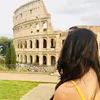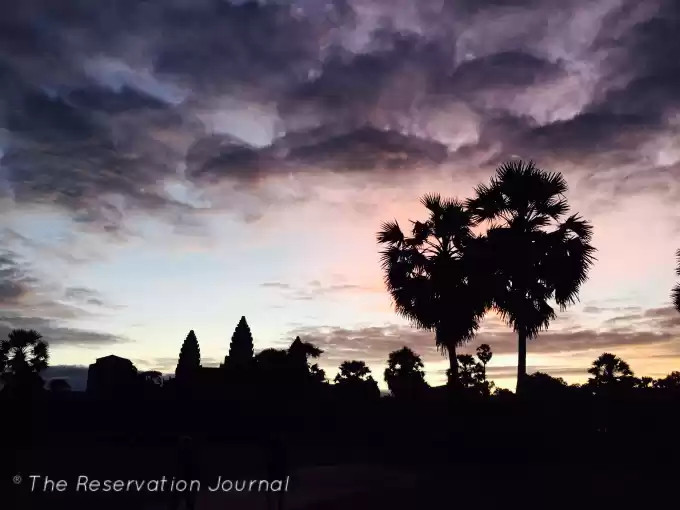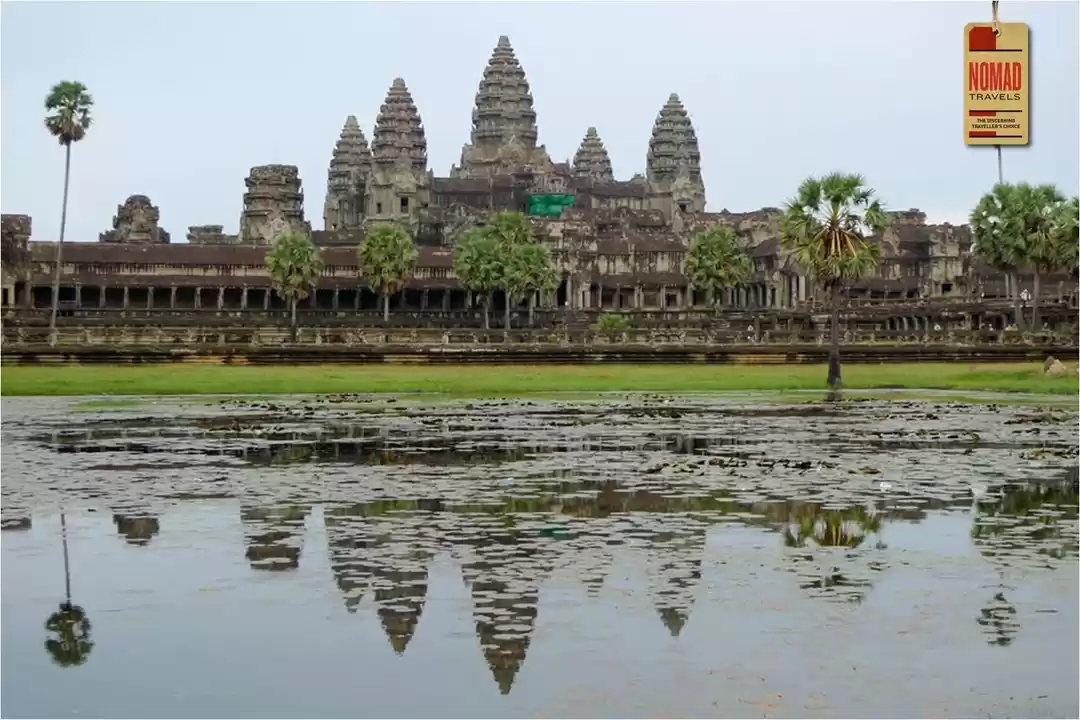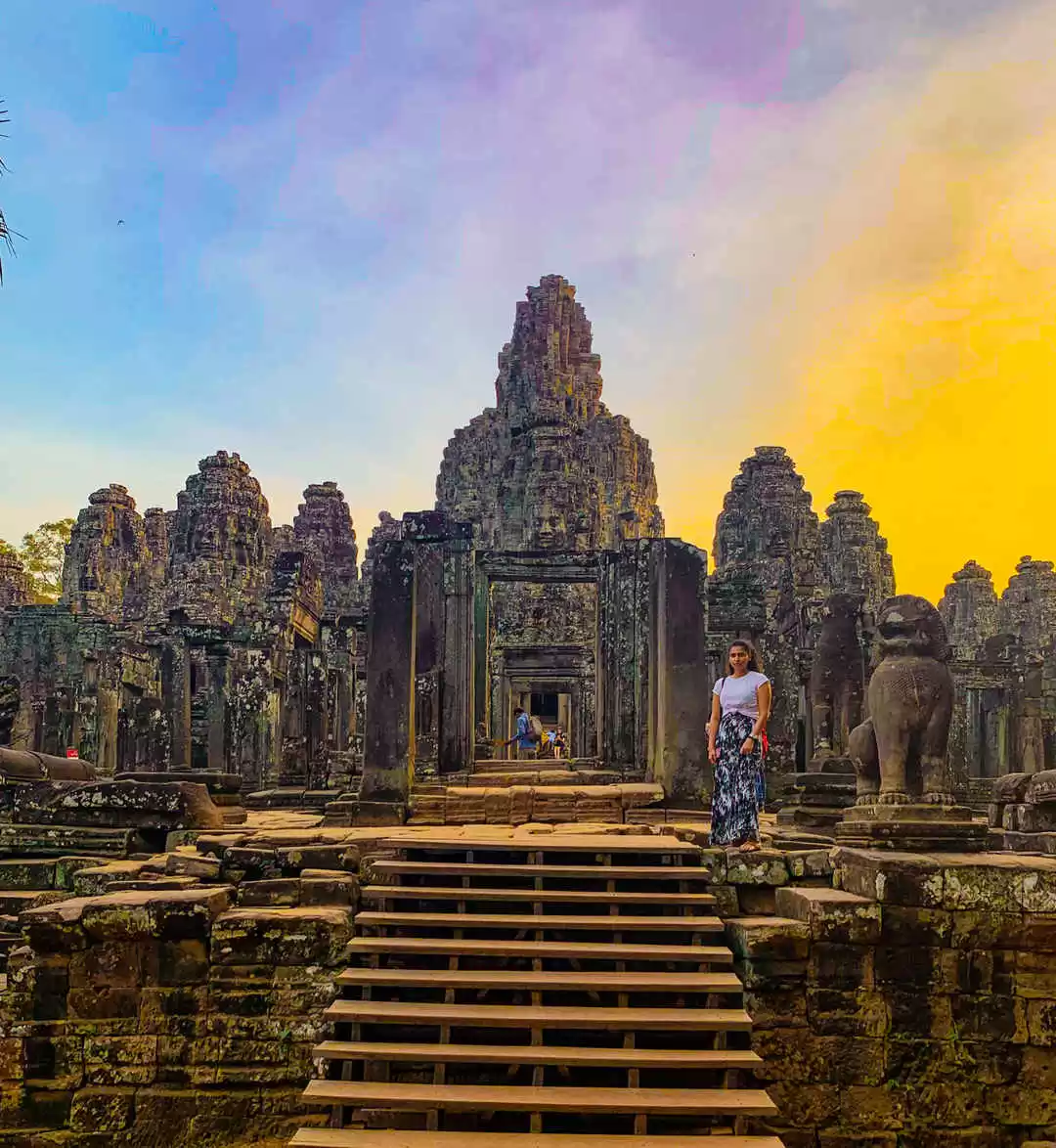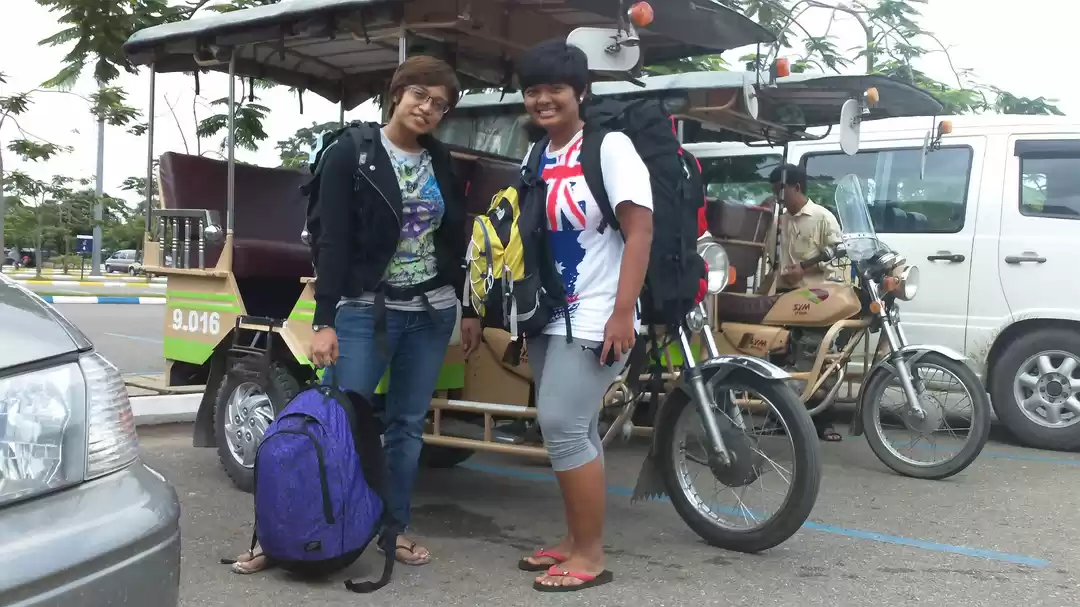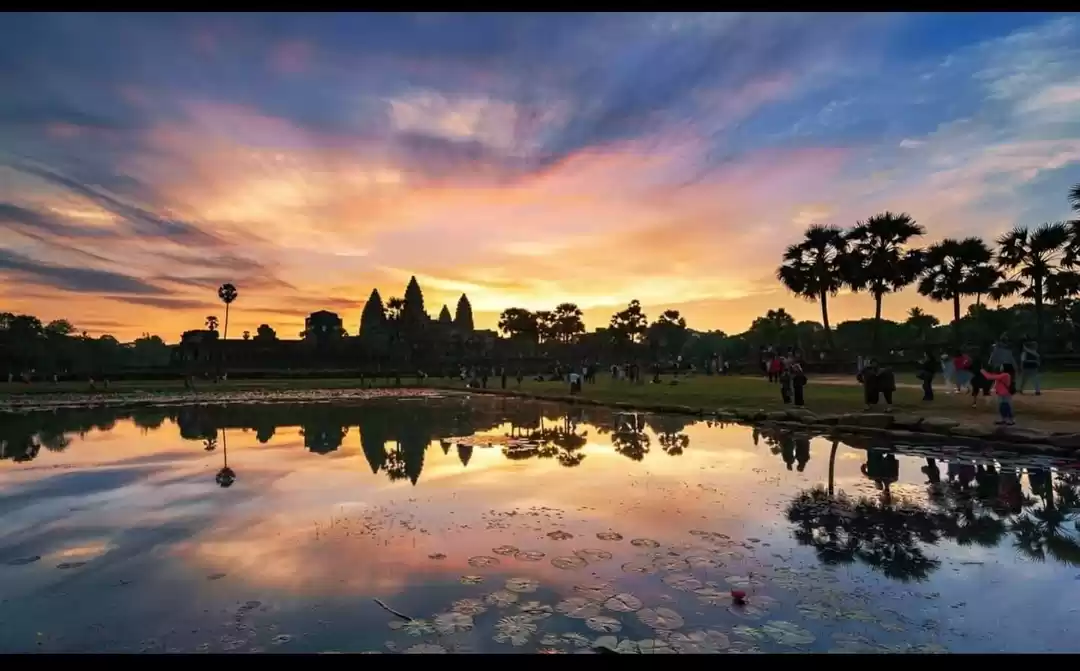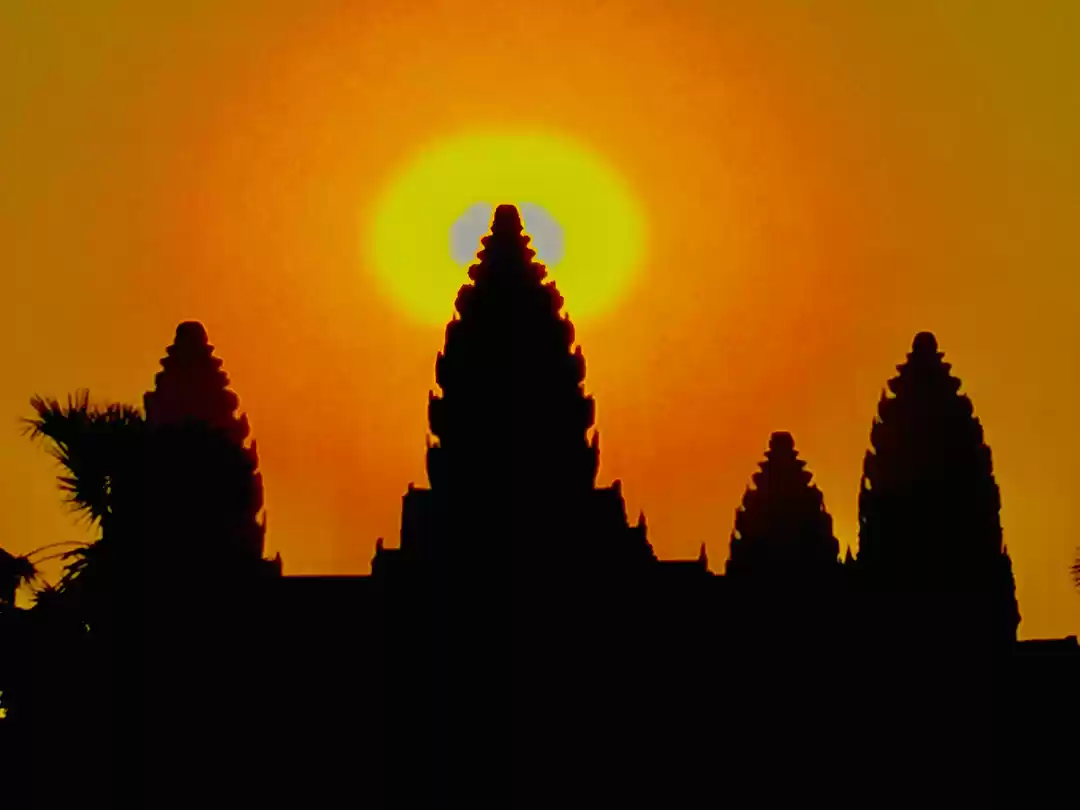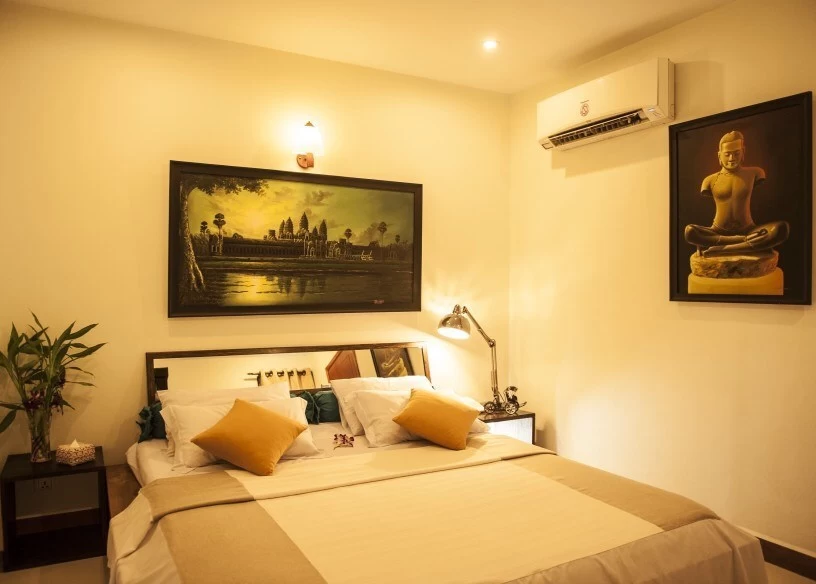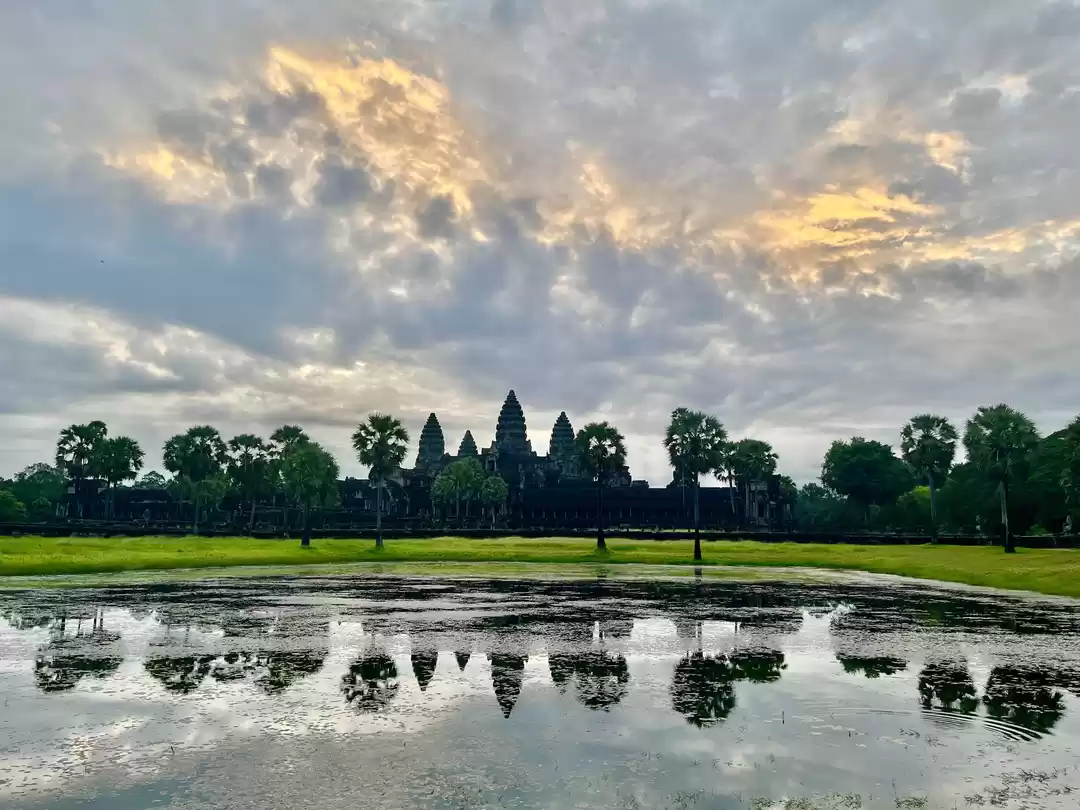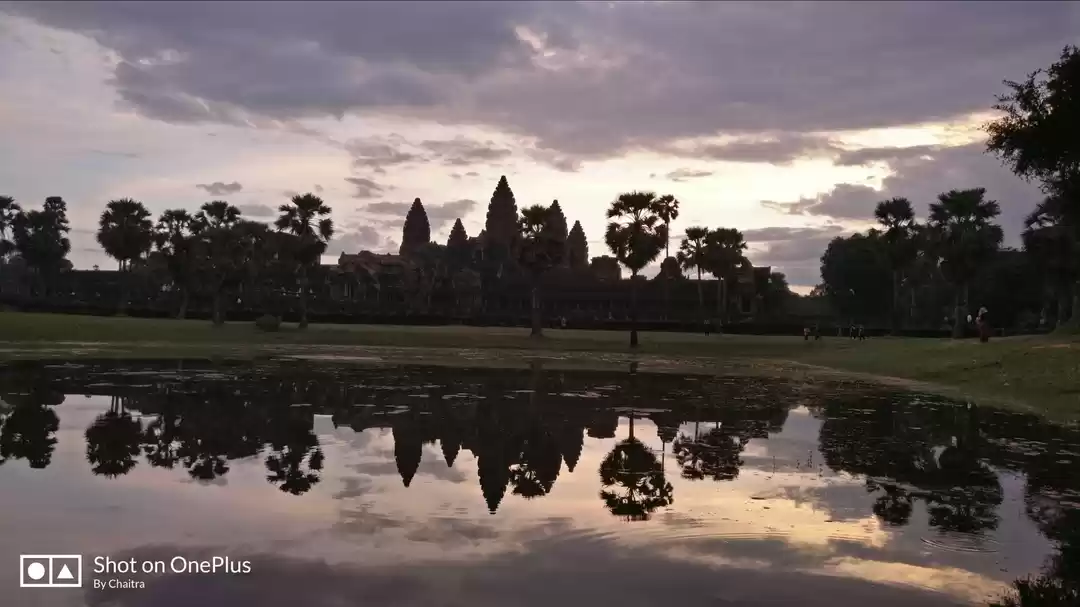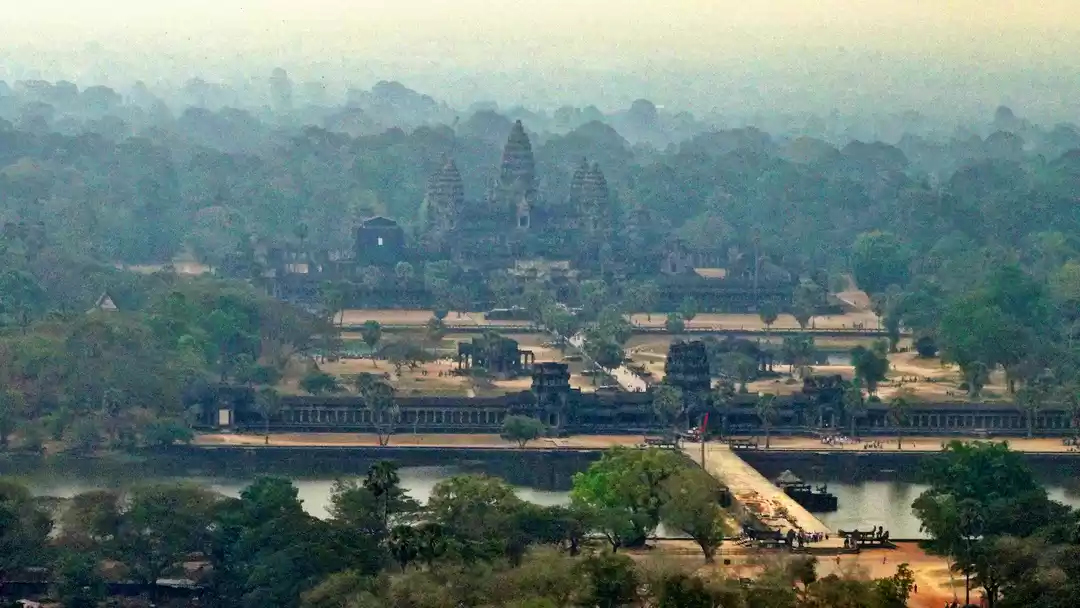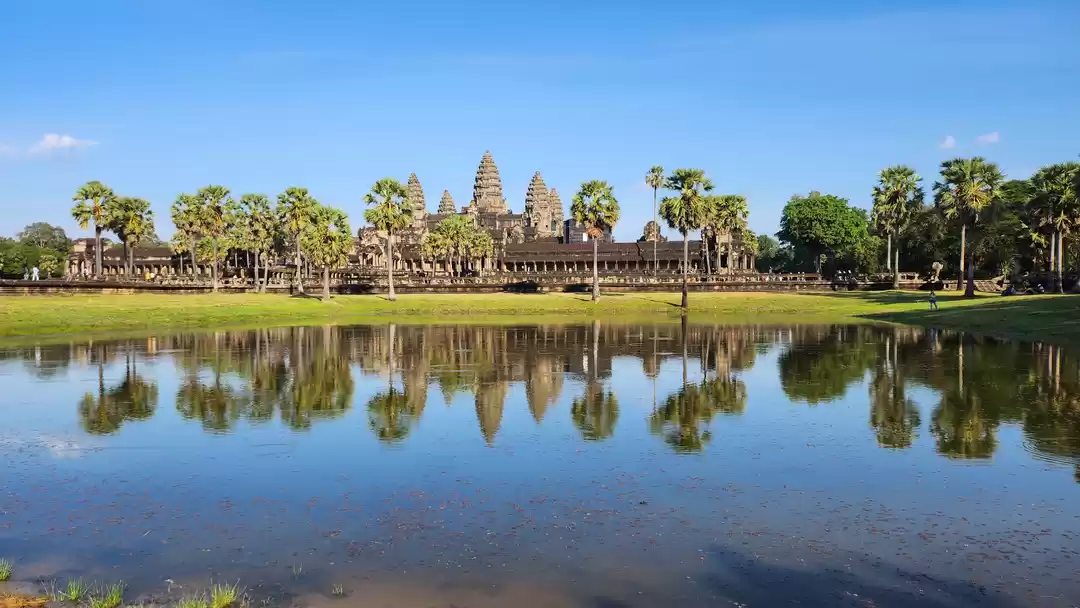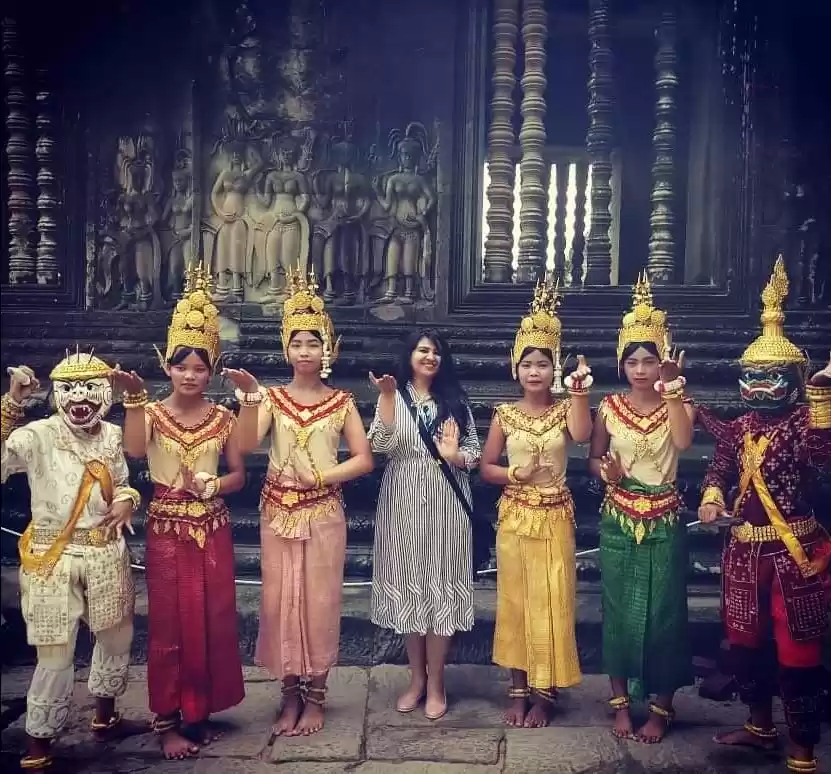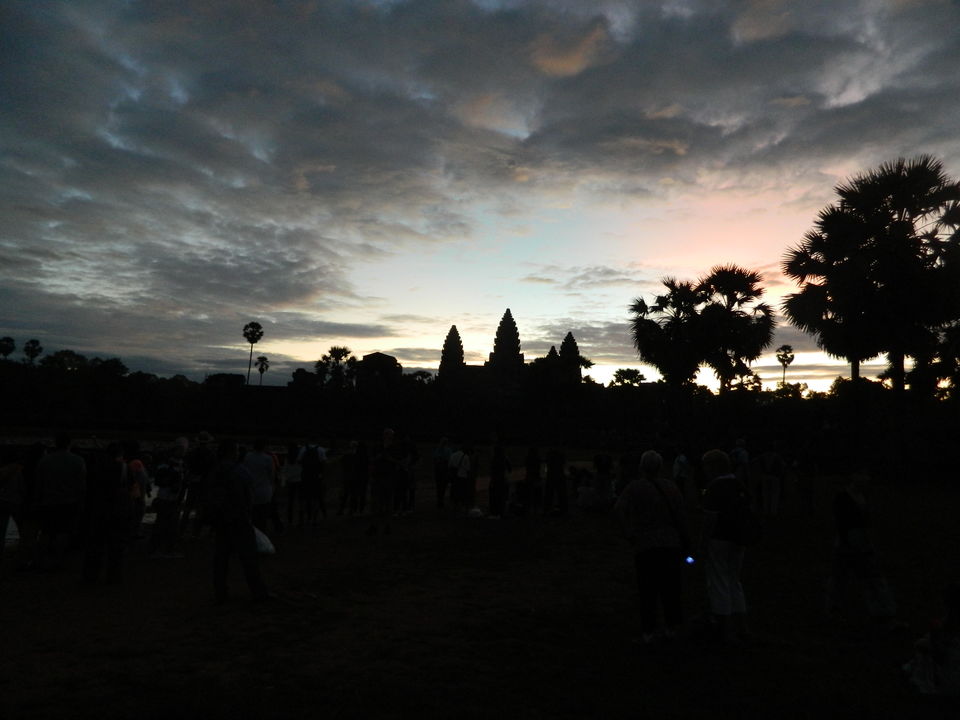
Bucket List ( Noun): A number of experience or achievements that a person hopes to have or accomplish during their lifetime.
Bucket list has been made famous after the movie by the same name starring Morgan Freeman and Jack Nicholson. Every person holds a bucket list close to their heart. While some could tick off all from the list, some others don't manage to tick off any. After ticking off Sandakphu (and I still can't get the image of the splendid Kanchenjunga out of my mind) from my list, I turned to conquering another magnificent one - the Angkor Wat!
After a month-long planning, speculations and research, we (I was accompanied by one of my friends) ultimately boarded the Indigo flight at 20:45 PM from Kolkata to Bangkok (Suvarnabhumi) where it would land around 12:05 AM. Once we touched down, we rushed towards the Passport Control area. Immigration procedure took almost 1-1.5 hours (we had already arranged our Thai visa from VFS, Kolkata), and we headed straight for Don Mueang Airport. We had exchanged the currency at one of the few counters opened at the airport (we would advise you to carry few Thai Bahts since the airport counters don't offer good exchange rates and you will have very few to no other options at such a late hour). The private taxi took around 30 mins to reach the other terminal. After a few hours wait, we boarded our Air Asia flight at 7:10 AM which landed at Phnom Penh International Airport at 8:25 AM. Please keep sufficient amount of time in hand since the check-in queue at DMK can take almost 2 hours or more.
While the flight was about to land, we noticed the plush landscapes around us. It was secluded from the skyscrapers and the humdrums of Bangkok. Getting off the flight, we headed straight for the Visa on Arrival section. Cambodia visa fee is $30 and it is advisable to carry the exact change in dollar bills. It took us not more than 10 minutes to get the Cambodian visa and thereafter we headed straight for Immigration and baggage collection. Once you exit the airport you can head towards the numerous counters offering tavellers' sim cards. We opted for a Cell Card one for $7 with unlimited internet usage for 7 days (one thing to remember here is that even if you opt for a 4G sim, do not expect the speed to be faster than 2G/3G). After that we took a tuktuk for $9 and headed straight to our "One Up Hotel" near the BKK area.
The One Up Hotel is situated at a 30 minutes tuktuk ride from the airport, hidden in an alley across the main road. This alley also has a number of hostels, restaurants and a Japanese Tapas bar. As we approached the reception area, we were immediately greeted by warm smiling faces. Escorting us to the font desk, they served us refreshing welcome drinks. The manager, Mr. Rith Son, photocopied our passport and also helped us pick the hotel tuktuk service for next day's trip to the Choeung Ek and Tuol Sleng museum. The hotel is a small, no-frills hotel with a very warm and welcoming touch. We had chosen the One Up Suite on the first floor. The air-conditioned room had a queen-size bed, wardrobe with a safety deposit box, TV and a small table and chair in the bedroom. Outside the bedroom was the kitchenette area with a fridge and a dressing table. The bathroom had a washbasin, WC and a shower panel with running hot/cold water. The room and the bathroom was cozy and clean with the basic amenities provided.
Room cost: $40-45 for a Standard One Up Room, without breakfast (prices may vary during high/low season)
After freshening up, we walked upto Mok Mony for a quick lunch (the Google map came very handy in this trip). This place is quite famous amongst the tourists and serves amazing Khmer food. The owner is very engaging and helpful and so are the staff. We ordered a plate of Fried noodles with chicken and the quantity was good enough for 2 people. And the bill was even better - $6!!! They even served us grilled banana as a complimentary dessert which tasted quite different but nice. Now, since we landed in Phnom Penh, we had been warned at our hotel, by tuktuk drivers and the owner of Mok Mony to beware of bag snatching - though we did not come across such unpleasantries during our trip, nevertheless do take care of your handbags while walking on the streets or travelling in a tuktuk!
After lunch, we went to see the Independence Monument which was only a few blocks away from the restaurant. It is a splendid structure constructed in 1958 to commemorate the victory of Cambodia over France in the same year. It stands in the centre of the city at the intersection of the 2 most important boulevards - Norodom and Sihanouk. From here, we hired a tuktuk to the famous Riverside (Sisowath Quay). We stopped at one of the Buddhist temples, Wat Ounalom. It is considered to be the most important wat of Phnom Penh and the center of Cambodian Buddhism. Wat Ounalom was established in 1443 and is said to be preserving an eyebrow hair of Buddha in one of the stupas located there.


The entrance of Wat Ounalom Independence Monument

Sisowath Quay - The riverside
Strolling along the Riverside, we headed towards the Foreign Correspondents Club (FCC) for a drink. As the name suggests, mostly foreigners throng this place. FCC offers a great view of the Riverside while serving drinks at cheap prices. And at a even cheaper price during their 4-7 PM happy hours! We ordered a glass of red and white wine (happily got a glass of Chenin Blanc for $3!!!) and the bill came to approx. $10 (they charge taxes!). We would suggest you to sit at the rooftop to catch a splendid view of the Riverside or the sunset and to enjoy the breezy evenings. After FCC, we decided to check out the local Night Market for some cheap bargains - but found none! Though you get varieties of items ranging from clothes, shoes, souvenirs to local street foods, they are exorbitantly priced, more so for the foreigners. From the riverside we headed near our hotel for dinner. Surprisingly, the restaurants close at 9:30 PM in the BKK area, so it would be wise to eat dinner near the Riverside. With no other options left, we had Chicken Caesar Salad with Kroutons and Tom-Yum soup at the Feliz Hostel and café. The food was delicious and the prices were affordable (approx. $10-12).
Choeung Ek Entry fee: $6 (includes the Audio Tour by Narrowcasters available in several languages).
Next day started at 7:00 AM as we prepared for a day-long visit to the Killing Fields and the S-21 museum. We had breakfast at the hotel consisting of baguette, croissant, jam, butter, a bowl of fresh fruits and juice. We had already booked the tuktuk from our hotel and the driver spoke English well. It was a 30 minutes tuktuk ride to the outskirts of Phnom Penh to reach the Choeung Ek - one of the Killing Fields during the Khmer Rouge.

Mass grave of 450 victims of the Khmer Rouge. You can still see fragments of clothes lying around

Mass grave of more than 100 women and children

Executioners thrashed children against this tree, killing them Bones, teeth and a shoe of the Khmer victims unearthed from Choeung Ek

The Choeung Ek Memorial

Skulls of the Khmer Rouge victims

Skulls and bones of the victims are arranged in 13 levels. They are segregated on the basis of age, sex and how they were killed

Choeung Ek is only one and the most important of the 300 Killing Fields in Cambodia, where several political prisoners from the S-21 prison were killed and buried during the Khmer Rouge between 1975-1979. It is located about 15 kms from Phnom Penh. Mass graves of 8985 bodies (men, women and children) were discovered at Choung Ek after the fall of the Khmer Rouge. Fragments of human bones and clothes are still scattered around the pits. Today, there stands a memorial stupa at Choung Ek, where more than 5000 human skulls, arranged by sex and age and human bones from the Tuol Sleng prisoners executed there are preserved. These remains are arranged in 13 levels and are open to tourists during the opening hours (7:30 AM - 5:30 PM). The audio tour includes how the prisoners were transferred from the S-21 detention centre in the middle of the night, how they were executed and also a chilling account of Him Huy, a Choeung Ek guard and executioner, Former Prison Director Duch and a few heart-wrenching stories of the survivors. There is also a museum that chronicles the brutalities that were carried out at the Killing Fields.
Tuol Sleng entry fee: $5 (additional $3 for the audio tour).

Prison cells at the Tuol Sleng

Prisoners were shackled to the walls of the cells with these chains

Rows and rows of cells at the Tuol Sleng, which was once a high school
After reliving the horror of the Khmer Rouge at Choeung Ek, we visited the Tuol Sleng Genocide Museum. The museum was formerly a high school, which was converted into the notorious Security Prison 21 (S-21) during the Khmer Rouge between 1975-1979. The buildings were enclosed in barbed wire and the classrooms were converted into tiny prison cells and torture chambers. Out of an estimated 20,000 prisoners at Tuol Sleng, only 7 survivors are known today.
Tuktuk fare for Choeung Ek and Tuol Sleng: $15-18 (stopover at the Russian Market would incur an additional $3-4).
Each prisoner was shackled to the walls of their cells with only minimal space for them to curl up to sleep. There red markings on the floor and we were not sure if it was blood or paint. While the ground floor prison cells showed how gruesomely the Khmer Rouge soldiers treated the prisoners, the other 2 floors were worse. Hardly any sunlight reached them and the cells were more cramped. On the other side of this, each classroom was converted into torture chambers. These chambers had a single bed where the prisoners were shackled to for days and months. One such chamber also had a chair and desk where the soldiers would observe the prisoner and would wait for them to confess.
Entry fee: $10


King Sisowath

The mythical bird Garuda

Sculpture of Vishnu
After the somber trip, we charged towards the Russian market for a little Khmer shopping. It is a flee market with all sorts of items on sale. Pick your souvenirs, clothes and coconut bowls from here at cheap bargains. You can also try the central market for jewelries (silver jewelry is famous here), rice paper painting and clothes. Don't miss the coconut water from the lady just outside the market for $1 (it was very refreshing).

Sunset along the Phnom Penh skyline from the Eclipse Sky Bar
We missed visiting the Royal Palace since sleeveless or dresses that end above the knee are not allowed (one of us was wearing sleeveless), but we did cruise through Cambodian history at the National Museum. The museum has a vast collection of Khmer art and sculpture in stone, bronze and ceramics. Many sculptures of Hindu gods and goddesses are also preserved here, like Ganesha, Vishnu, Lakshmi, etc.
Mekong Express bus fare to Siem Reap: $13
After the historical and cultural day spent at Phnom Penh, we hopped onto a tuktuk to go to the much acclaimed Eclipse Sky Bar, located at the 23rd floor of the Phnom Penh Tower. This is an ideal place to catch a glimpse of the setting sun along the busy Phnom Penh skyline. The rooftop bar has a casual setting with fine furnishings offering a splendid view. Sipping on a $6 cocktail or a $2.5 beer and chomping on a $5 chicken wings, gives you the feeling that life cannot get any better than this!
Room rate: $45-50 onwards (may vary during high/low season)




Next morning, we started off for Siem Reap - our destination. We had already reserved seats with Mekong Express for $13 from our hotel and the bus service picked us up at 7:30 AM. The bus is a Volvo kind of a luxury bus, air conditioned and with wi-fi. It started off at 8:30 AM and we were handed over a refreshment box of a non-veg patty, a cupcake and a bottle of water each. It took us about 6 hours to reach Siem Reap, with only one stop for lunch (the bus had a toilet so they did not stop for toilet breaks). They dropped us off at the bus office in Siem Reap. The road condition was good and the driver drove within the speed limits and carefully.


Scenes at the Pub Street
On reaching Siem Reap, we were picked up by our hotel Residence101 from the bus office. Usually, they provide complimentary airport pick-up, but Mr. Hat was nice enough to accommodate our pickup from the bus station. The hotel is located a little away from the main town, but just 1 km away from the nightlife of Pub Street. Residence101 is a small boutique hotel with all the amenities provided by the luxury hotels. A swimming pool, bar cum restaurant, in-room spa/ massage, tuktuk services for Angkor tours - everything was available. Just as we reached the hotel, we were greeted with a lemongrass oil infused cold towel and a refreshing welcome drink, and did we think we just arrived at heaven? Yes, we did!!! The lady at the reception provided us with the basic information about the city and with a map of the Angkor Archaelogical Park. On entering our room, we were stunned by a pleasant welcome message on the bed. Being 2 girls travelling alone, we were overwhelmed with the hospitality. The room was huge with a queen-size bed, safety deposit box, in-room washbasin and a balcony looking out towards the main road. The bathroom was clean with a shower panel with hot/ cold water supply, WC and toiletries (I quite liked their shampoo). Being very tired after the 6 hours bus journey, we rested for a bit (they even provided us with a welcome bowl of fruits which we devoured in seconds!).
Angkor Archaeological Park Entry Fee: Tickets can be bought for 1 day ($37), 3 days ($62) or 7 days ($72). This ticket includes all the temple circuits mentioned above (It does not include the entry fee to the Kulen mountains).
In the evening, we took a tuktuk to the famous Pub Street. It was a walking street (only mellowed down and decent), with rows of restaurants and pubs on either side of the 2 blocks. Few of the notable ones are - Red Piano (favorite with Angelina Jolie during the Tomb Raider days), Banana Leaf, Easy Speaking (serves a degustation menu of barbecued frog legs, kangaroo, squid, crocodile, snake, ostrich and more) , Picasso, Angkor What?(this bar is quite famous with the foreigners), Temple Club (which belted out great tracks) and many more. We usually spent our evenings at the Pub Street and only used to get back to our hotel after dinner. Cocktails are usually priced at $5, liquor $3-$4 and dinner at $5 per mains. We tried the Fish Amok here and the chicken loklak, both very tasty dishes. You can shop at the Night market and the central market here for good, cheap stuff. At Pub Street, we hired a tuktuk (driver's name was Wint, spoke English and was very nice) for our Angkor Wat tour for the next 3 days.
The Angkor Archaeological Park can be divided into 4 segments: 1) Angkor Wat and Angkor Thom (2) Temples of the Little Circuit (3) Roulos group (4) Temples of the Greater Circuit (5) Outlying Temples

Sunrise at Angkor Wat
The next day started early at 4 AM for the Angkor Wat sunrise. Sleepily, we dragged ourselves out of the bed and rode on the tuktuk till we reached the APSARA ticket office. Here, we got the 3 days pass for $62 (the passes will have your photo on it, carry it everywhere with you and DO NOT lose it). This pass was our gateway to the huge Angkor Archaelogical Park sprawled over acres of land. The Angkor Wat is situated at a distance of 30-45 mins from the main city of Siem Reap.

(Topmost) Angkor Wat. Buddhist sculptures that are still worshipped there


The Naga at the causeway of the south gate

Rows of Asuras on one side churning the Naga

The South gate to Angkor Thom


As we rushed out of your tuktuk (the sky was getting ready for the sunrise), we hurdled across the steps and the moat surrounding the temple and entered through the West gate. Lo and behold! There lies one of the greatest creation of mankind - the oldest and the largest religious architecture in the world - the vividly beautiful Angkor Wat. I was never known to be a God-fearing person nor am I an Atheist, but I was certainly mesmerized by the striking Angkor! We rushed towards the pond with the lotus for a sunrise shot of the temple (there were thousands of tourists already gathered there, ready with their cameras and tripods), and just when the sky was ready...my camera bombed!!! I took to my iPhone, which acted as a savior at that moment.

Smiling faces at the Bayon temple
Angkor Wat ("Temple City" or "City of Temple") was originally built as a Hindu temple devoted to God Vishnu in the early 12th century by the Khmer King Suryavarman II. Angkor Wat was his state temple in the capital city of Yasodharapura (present day Angkor). Towards the end of the 12th century, Angkor Wat gradually transformed to a Buddhist centre of learning. The temple is a representation of Mount Meru, the home of the Gods. Intricate designs adorn the walls of the temple. There is a statue of Buddha amongst the ruins which the monks still worship. The temple has an outer gallery and an inner gallery "bakan". The bakan is a steep climb and offers a great view from the top (again sleeveless dresses, shrugs and uncovered knees are not allowed).

Causeway to Baphuon

Baphuon temple

Notice the Reclining Buddha?
From the Angkor Wat, we proceeded towards the Angkor Thom - the last capital city of the Khmer empire. It was established in the late 12th century by King Jayavarman VII. The city lies on the banks of the Siem Reap River. The south gate walls are flanked by a moat on all sides. The gates are ornated with Bayon-like faces of the King himself, the bodhisattva Avalokiteshvara, guardians of the empire's cardinal points. The causeway to the gate have rows of deva on the left and asura on the right side, each row holding a 7 headed naga in a tug-of-war style.
The most famous and important of all the Angkor Thom temples is the Bayon. The Bayon is notable for a cluster of smiling faces on the upper terrace of the temple. While few of the historians have speculated the faces to be of the King Jayavarman VII, many others believe it to be of the bodhisattva of wisdom - Avalokiteshvara.
Bayon temple

Ta Keo temple
After Bayon, is the Baphuon - a 3 tiered temple mountain. This temple is dedicated to Shiva. It also has a reclining Buddha carved on the wall if you observe sharply.


Tuktuk fare for Day 1: $16-18


Pics from Banteay Kdei


The Terrace of the Elephants was used by Jayavarman VII to watch his victorious returning army. The terrace is named after the elephant carvings on one of its face. The Phimeanakas palace is in a dilapidated form and is inaccessible to tourists.

One of the 6 towers at Preah Ko

Shiva linga in ruins

Nandi, the bull

Inscriptions on the wall of one of the towers at Preah Ko
The Terrace of the Leper King draws its name from the statue of the Hindu God of death - Yama, discovered there. The statue was discoloured and covered with moss giving the impression of a person with leprosy. Thus the term "Leper" king.

Causeway to Bakong

The temple complex of Bakong

Monastery at the top of Bakong
From Angkor Thom we moved towards the Little Circuit of temples. We started off with Ta Keo which was built of sandstone. This was the state temple of Jayavarman V. It has five towers and surrounded by a moat. This temple was dedicated to Shiva, as evident from the presence of Nandi, the Bull. Ta Keo was under restoration when we had visited so we couldn't take many photos.

Lolei temple under restoration
From Ta Keo we rode towards the famous Ta Prohm, made famous by the Hollywood movie Tomb Raider where it was used as a location. Ta Prohm was built by Jayavarman VII in the late 12th and early 13th century. The temple also served as a Mahayana Buddhist monastery and university. Ta Prohm is popular with the tourists for its photogenic trees growing out from the temple walls. Jayavarman VII constructed Rajavihara (or Ta Prohm) in honor of his family. The temple's main image represented Prajnaparamita (the personification of wisdom) and was a representation of his mother. The trees growing out of the ruins of Ta Prohm has been the temple's main attraction. Ta Prohm has been listed by UNESCO under the World Heritage List in 1992. The restoration of the temple has been since taken up by the Archaeological Survey of India and APSARA (Authority for the Protection and Management of Angkor and the region of Siem Reap).
Banteay Kdei (Citadel of Monks) is a Buddhist temple built during the reign of Jayavarman VII. Its architectural style is similar to Bayon. Infront of Banteay Kdei is the Srah Srang which was the royal bathing pool. The color of the water is turquoise blue and is surrounded by large trees. Its a perfect place to watch the sunset, if you want to avoid the crowd at Phnom Bakheng.

The next morning started early as we embarked on our Roluos Group and Big Circuit tour of the Angkor Archaeological Park. Our first stop was Preah Ko or the Sacred Bull. This temple was dedicated to Shiva. The temple was built in 6 towers, 3 in front and 3 in back, each tower dedicated to the family members of the King Indravarman I who built the temple.

Intricate carvings on the wall of one of the towers at West Mebon

Buddha statue being worshipped at West Mebon
Preah Ko


Temple ruin of Ta Som

Apsara carvings on the wall

Carvings at Ta Som
After Preah Ko, the next temple in the Roluos group is the Bakong. Bakong is the first temple made of sandstone by the Khmer rulers. King Indravarman I built Bakong as the state temple of the city of Hariharalaya (knows as Roluos today). The temple is surrounded by a moat and the causeway is adorned with seven-headed nagas on both the sides. The brick red road that leads to the temple complex is surrounded by beautiful trees with pink flowers in bloom. The central temple is built in the typical Mount Meru type. The temple complex has a lot of structural ruins which indicates the importance of Bakong as a state temple in that era. You will have to climb up the high and steep stairs to the main tower guarded by statues of lions. Though Bakong was originally dedicated to Shiva, it now houses a small statue of Buddha.

Causeway to Neak Pean

One of the smaller ponds at Neak Pean

The central pond at Neak Pean. The temple and the horse Balaha can be seen in the pic
From Bakong we visited Lolei temple built by Indravarman I. The temple was dedicated to Shiva and the royal family members. Lolei used to be an island temple which has dried up now. The temple was under restoration during our visit.

Causeway to Preah Khan

Temple complex of Preah Khan

After completing the Rulous group of temples, we rode the tuktuk back into the Angkor Archaeological Park to visit the temples of the Big Circuit.
Tuktuk fare for Day 2: $20-22

Pre Rup temple

One of the towers at sunset

Sunset from Pre rup
We started off with West Mebon which was built during the reign of Rajendravarman. It was built on an island in the middle of a water body which has dried up today. West Mebon was dedicated to Lord Shiva and the parents of the king. The stairs lead up to the main temple. There is an elephant structure at the temple.

Hike to Kbal Spean waterfall

Shiva linga and carvings on the riverbed

Thousand lingas at Kbal Spean

Kbal Spean waterfall
West Mebon
Tuktuk fare for Day 3: $25-28

Outer complex of Banteay Srei

Shiva linga at Banteay Srei

Inner complex of Banteay Srei
Our next stop was Ta Som, built during the reign of Jayavarman VII and dedicated to his father Dharanindravarman II. The temple is covered with huge fig trees growing out from the ruins. There are two libraries on either side of the temple.
Bus fare to Bangkok: $27 (Nattakan Transport)
Prasat Neak Pean (entwined serpants), the temple island was built during the reign of Jayavarman VII. The temple needs to be approached by crossing a lake with shallow water. The long wooden walkway makes the 3-4 mins walk quite enjoyable. At Neak Pean, a central pond is surrounded by 4 smaller ponds. The central pond symbolises Lake Anavatapta, a mythical lake in the Himalayas thought to cure illness. Thus Neak Pean was designed as a hospital whose water was used to cure sick people. The four smaller ponds symbolises Water, Earth, Fire and Wind. Each of these pools are connected to the main pool by stone structures of Elephant, Bull, Horse and Lion corresponding to North, East, South and West. Water used to flow through the mouth of these animals and the pilgrims would cleanse themselves with the healing water. The central pond holds a small temple whose base is encircled by two nagas, giving the temple island its name. Today only the statue of the horse remains, who is believed to be Balaha, a form of Avalokitesvara.
Preah Khan (sacred sword) was built by Jayavarman VII to dedicate it to his father. Preah Khan had acted as a temple city with common people residing just outside the temple complex. The temple even had wealth in gold, silver and gems. In the outer enclosure there are sculptures of the mythical bird Garuda fighting Naga snakes. The next enclosure was the "House of Fire" or dharamsala. Next is the Hall of Dancers whose walls are adorned with carvings of Apsaras. Next to the hall were two libraries. The main temple was Buddhist where the king's father was depicted as Avalokitesvara. The other three temples were dedicated to Shiva, previous rulers and Vishnu. There are carvings of Vishnu reclining on Ananta, Krishna lifting Mount Govardhan, Vishnu, Brahma and several battle scenes. Like Ta Prohm, Preah Khan also has several huge trees growing amongst the ruins.
Our last stop for the day was Pre Rup, built by Rajendravarman and dedicated to Shiva. Pre Rup means "turning the body" which refers to the fact that the temple also acted as a crematorium where the corpses were turned in all directions while burning them. There are four towers at the top that housed deities of Lakshmi, Uma, Vishnu and Shiva. Pre Rup is a famous spot for sunset. We skipped Phnom Bakheng to view sunset from here. It is a steep climb to the top of the temple. Pre Rup gives a beautiful view of the Sun setting amidst the plush green landscape.
We had kept Banteay Srei and the Kbal Spean waterfall for the last day visit. We started a little late in the morning. The tuktuk drive to Kbal Spean waterfall takes around 1 hr from the city. It is a 1.5 km (40 mins) hike upto the waterfall through the forests of the Kulen mountain. The site was discovered in 1969 and was opened for the tourists only in 1989. The riverbed cuts through sandstone formations and many mythological figures had been carved on the sandstone. There are 1000 Shiva lingas carved on the sandstone along with Vishnu, Lakshmi, Brahma, Shiva, Rama and Hanuman. The lingas were carved during the reign of King Suryavarman I and the rest of the carvings were made by hermits who once inhabited the forest. The hike is relatively hard and leaves you breathless though the meandering path has been marked well by APSARA.
We moved onto Banteay Srei, our last stop for the day. Banteay Srei means "city of women", though the earlier name of the temple was Isvarapura, the "city of Shiva". The temple also served as a pilgrimage site where the inner complex was reserved for the wealthy and the outer one for the common people. Banteay Srei is built of red sandstone and dedicated to Shiva. The temple is known for its intricate carvings.
As our stay at Siem Reap ended the next day, we were picked up by the Nattakan Transport from our hotel at 7:30 AM. Nattakan is one of the two transport companies that plies buses between Siem Reap and Bangkok. The bus is a luxury one with comfortable seating and adjustable leg rest. It even had a toilet on board, but no wi-fi service. There were only 5 of us (and all foreigners) travelling to Bangkok that day. The bus left the station at 8:00 AM and within 2.5 hours we reached the Poipet border. On boarding the bus, each of us were given a cupcake, a can of cold coffee, a juice pack and bottle of water. The immigration formalities at the Cambodian side took not more than 10 mins. From the Cambodian side we had to carry our luggages to the Thai side (Aranyaprathet) for Immigration. It is a 5 mins walk to the office and a Nattakan official lead the way. It took around 1.5 hours to get the Entry stamp into Thailand. As we boarded the bus again, we were given lunch packs (egg fried rice) which was tasty. We reached Bangkok in another 4 hours, though the traffic snarl took another 1 hour to get dropped at the Mochit Terminal. The Nattakan person was also kind enough to exchange our USD to Thai Baht since we were not carrying any Thai currencies.
This trip had been a memorable experience as we travelled back in time at Siem Reap and condemned the Khmer Rouge at Phnom Penh. We had scaled the largest temple in the world, walked miles every day and even hiked through jungles. Some day i will go back again to this wonderful country to lose myself in time at the glorious Angkor Wat or to see the Beng Mealea and the Kulen mountain (which we had missed due to time constraint) or just simply laze around on the beaches of Sihanoukville. Very few places leave a lasting impact on me and Cambodia has definitely been one!
Angkor wat - ✔️
Things to carry:
1) Clothes that would cover your knees and shoulders (but light and breezy clothing)
2) Sunscreen with the high SPF
3) Medicines
4) Toiletries
5) A good pair of hiking shoes/ comfortable slippers
6) Sunglasses
7) Hats/ Caps
8) Mosquito repellant
For more travel stories, please visit: https://www.thetraveltreasures.com

